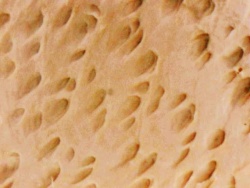Difference between revisions of "Crust leather"
(Created page with "<p align=center> 300px </p> '''Crustleder''' ist Leder, das nach der Gerbung getrocknet, aber noch nicht Lederfarbe|ge...") |
|||
| Line 4: | Line 4: | ||
| + | ==Crust leather== | ||
'''Crustleder''' ist [[Leder]], das nach der [[Gerbung]] [[trocknen|getrocknet]], aber noch nicht [[Lederfarbe|gefärbt]] ist. Bei chromgegerbten Ledern spricht man dann von "Chrom-Crust" oder bei [[pflanzlich gegerbtes Leder|pflanzlich gegerbten]] Ledern von "Pflanzen-Crust". Ein weiterer Begriff für "Crustleder" ist "Borke" oder "Borkeleder". | '''Crustleder''' ist [[Leder]], das nach der [[Gerbung]] [[trocknen|getrocknet]], aber noch nicht [[Lederfarbe|gefärbt]] ist. Bei chromgegerbten Ledern spricht man dann von "Chrom-Crust" oder bei [[pflanzlich gegerbtes Leder|pflanzlich gegerbten]] Ledern von "Pflanzen-Crust". Ein weiterer Begriff für "Crustleder" ist "Borke" oder "Borkeleder". | ||
| Line 34: | Line 35: | ||
''Sehr selten. Chrom-Crust weiterverarbeitet. Die Färbung ist so nicht ansprechend. Daher eher eine "Billig-Lösung".''<br></p> | ''Sehr selten. Chrom-Crust weiterverarbeitet. Die Färbung ist so nicht ansprechend. Daher eher eine "Billig-Lösung".''<br></p> | ||
<p> </p> | <p> </p> | ||
| + | |||
| + | ==Crusting leather== | ||
| + | Crusting is when the hide/skin is thinned, retanned and lubricated. Often a coloring operation is included in the crusting sub-process. The chemicals added during crusting have to be fixed in place. The culmination of the crusting sub-process is the drying and softening operations. Crusting may include the following operations: | ||
| + | |||
| + | wetting back - semi-processed leather is rehydrated. | ||
| + | sammying - 45-55%(m/m) water is squeezed out the leather. | ||
| + | splitting - the leather is split into one or more horizontal layers. | ||
| + | shaving - the leather is thinned using a machine which cuts leather fibres off. | ||
| + | neutralisation - the pH of the leather is adjusted to a value between 4.5 and 6.5. | ||
| + | retanning - additional tanning agents are added to impart properties. | ||
| + | dyeing - the leather is coloured. | ||
| + | fatliquoring - fats/oils and waxes are fixed to the leather fibres. | ||
| + | filling - heavy/dense chemicals that make the leather harder and heavier are added. | ||
| + | stuffing - fats/oils and waxes are added between the fibres. | ||
| + | stripping - superficially fixed tannins are removed. | ||
| + | whitening - the colour of the leather is lightened. | ||
| + | fixation - all unbound chemicals are chemically bonded/trapped or removed from the leather | ||
| + | setting - area, grain flatness are imparted and excess water removed. | ||
| + | drying - the leather is dried to various moisture levels (commonly 14-25%). | ||
| + | conditioning - water is added to the leather to a level of 18-28%. | ||
| + | softening - physical softening of the leather by separating the leather fibres. | ||
| + | buffing - abrasion of the surfaces of the leather to reduce nap or grain defects. | ||
| + | |||
<werbebanner /> | <werbebanner /> | ||
| Line 39: | Line 63: | ||
== Additional information == | == Additional information == | ||
| − | * [[ | + | * [[Tanning leather]] |
* [[Wet blue]] | * [[Wet blue]] | ||
* [[Wet white]] | * [[Wet white]] | ||
Revision as of 21:35, 13 November 2016
Crust leather
Crustleder ist Leder, das nach der Gerbung getrocknet, aber noch nicht gefärbt ist. Bei chromgegerbten Ledern spricht man dann von "Chrom-Crust" oder bei pflanzlich gegerbten Ledern von "Pflanzen-Crust". Ein weiterer Begriff für "Crustleder" ist "Borke" oder "Borkeleder".
Crustleder wird nur selten weiterverarbeitet. Meist werden die Leder vor der Verarbeitung noch gefärbt und zugerichtet.
"Pflanzencrust" - "Chromcrust"
Pflanzliche Crustleder verarbeitet.
Sehr selten. Chrom-Crust weiterverarbeitet. Die Färbung ist so nicht ansprechend. Daher eher eine "Billig-Lösung".
Crusting leather
Crusting is when the hide/skin is thinned, retanned and lubricated. Often a coloring operation is included in the crusting sub-process. The chemicals added during crusting have to be fixed in place. The culmination of the crusting sub-process is the drying and softening operations. Crusting may include the following operations:
wetting back - semi-processed leather is rehydrated. sammying - 45-55%(m/m) water is squeezed out the leather. splitting - the leather is split into one or more horizontal layers. shaving - the leather is thinned using a machine which cuts leather fibres off. neutralisation - the pH of the leather is adjusted to a value between 4.5 and 6.5. retanning - additional tanning agents are added to impart properties. dyeing - the leather is coloured. fatliquoring - fats/oils and waxes are fixed to the leather fibres. filling - heavy/dense chemicals that make the leather harder and heavier are added. stuffing - fats/oils and waxes are added between the fibres. stripping - superficially fixed tannins are removed. whitening - the colour of the leather is lightened. fixation - all unbound chemicals are chemically bonded/trapped or removed from the leather setting - area, grain flatness are imparted and excess water removed. drying - the leather is dried to various moisture levels (commonly 14-25%). conditioning - water is added to the leather to a level of 18-28%. softening - physical softening of the leather by separating the leather fibres. buffing - abrasion of the surfaces of the leather to reduce nap or grain defects.
Additional information












 a kotori web solution
a kotori web solution